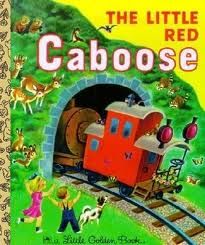The Art of Tibor Gergely in The Little Red Caboose
Milestone alert: my son sits for full-length picture books.
He sits for book after book after book at bedtime in our reading chair, books that he now identifies by name: “Moon!” “Ea Pea Pear Pum,” “All Fall Down.”
He sits for book after book at breakfast time “Readit!” “Gain!” “Book!”
And he sits for one book in particular, anytime:
The Little Red Caboose by Marian Potter, illustrated by Tibor Gergely (Random House, 1953).
Our favorite time to one-eyed-read (the other eye is still sleeping) this Golden Book Classic is at 6:20 a.m., snuggled in my bed or the oversized chair in the living room.
I am stretching out the last few minutes of nighttime peace…
My son is yelling:
“Boose!” “Boose!”
“Readit!”
OK.
My sleepy voice is scratchy, but slowly and quietly I find the first words: “The little red caboose always came last.”
The story is likely as familiar to you as it was to me even before I began reading it to my son. Originally published in 1953, children, including child-me, have been cheering the little red caboose for decades—I did most of mine in the 80s.
There is much to cheer about.
A lesson in locomotive anatomy: “First came the big black engine…then came the boxcars…then the oil cars…then the coal cars…then the flat cars…”
Perfect picture book writing, with repetition and ontomoneptiea: “puffing and chuffing,” “clickety clack,” “bump!”
This line: “‘Oh, smoke!’ said the little red caboose. ‘I wish I were a flat car or a coal car or an oil car or a boxcar, so boys and girls would wave at me.’”
Go ahead, say it out loud: “Oh, smoke!”
“Oh, smoke!”
“Oh, smoke!”
Of course after the little red caboose “…slammed on his brakes…held tight to the tracks…and kept that train from sliding down the mountain!” everybody does “…save their biggest waves,” for him.
My son enjoys the well-crafted language, and I can tell he senses the significance of the plot, but it is Tibor Gergely’s illustrations that really keep him engaged for all thirty-two pages.
There is so much to look at.
My son’s favorites: the “deer,” the “bear,” the “lion,” the “bus,” and another “bus.”
I am drawn to the way Gergely pushes the boundaries of proportion and perspective.
On one spread is the entire train, but on another, the engine is coming out of one tunnel while the caboose is just entering another, in a completely separate (and huge) mountain. On this spread the train got longer.
In another picture, the train simultaneously passes a circus, a small lake with a beach and a boathouse, a gas station and a major highway. Beyond the road there is the skyline of a village, and off on the horizon is a factory blowing smoke. There are very few words on this spread, but it takes us a long time to turn the page.
Another of Gergely’s appealing oddities is his repeated placement of horses (either drawing carriages or being ridden) in close proximity with cars. In one picture there is a horse drawn carriage on the same road as a quirky mix of cars—a 50s Buick, a VW Van and a Model T Ford.
There are additional historical inaccuracies. As the train heads up the mountain it passes a settlement of Native Americans, and their dress and behavior do not match the time period in which the book was published.
Perhaps this is because Gergely was developing his quintessential, albeit stereotypical, Americana theme that permeates each picture. There are American flags, kids flying kites, neat little colonial houses and gardens, church steeples, lumberjacks and wild animals roaming freely through the hills.
This is interesting, given that Tibor Gergely (1900-1978) was born in Budapest. According to the Tibor Gergely website, Gergely spent many years in a circle of esteemed Hungarian artists and intellectuals, drawing caricatures, painting with oils, and perfecting his drawing. In 1939, anticipating the German arrival in Hungry, Gergely left for the United States. “From the minute he set foot on the island of Manhattan, Gergely was intoxicated by its buildings, skylines, bridges and bustle,” the website explains.
Link here: http://www.tiborgergely.com/site/About_Tibor_Gergely.html
The Little Red Caboose is not just about self-esteem. Open to any page and you know it is also about “buildings, skylines, bridges and bustle.” The bustle of American life in the 1950s.
Again according to the website, Gregely went on to illustrate more than seventy Golden Books, including another childhood favorite of mine: Scuffy the Tugboat.
But back to the The Little Red Caboose…
Written and illustrated in the 50s, read to me in the 80s, to my son today, and to his children in another thirty years? I would certainly imagine so.
“Boose” truly is, timeless.
This post is dedicated to my brother, Brian. I have good memories of him yelling out “tain! tain!” and waving frantically to all the cars as they passed him by–even the little red caboose.


Leave a comment